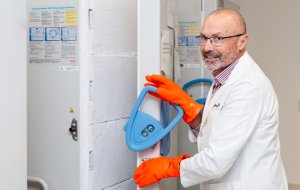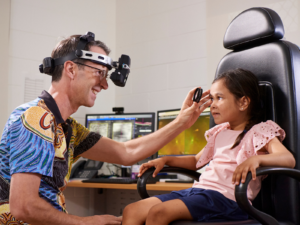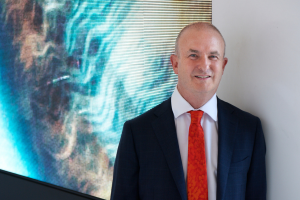Telethon grants will enable researchers at the Lions Eye Institute to create eye growth charts for children, identify children at high risk of myopia, revolutionise treatments for vision loss related to diabetes and implement crucial screening programs.
Congratulations to the following Lions Eye Institute researchers, whose transformative work will ensure the children of Western Australia receive world-leading treatment and care for blinding childhood conditions.
Professor David Mackey AO – Myopia prevention: Creating eye growth charts for children

Professor David Mackey AO
Combatting the growing global problem of myopia, or near-sightedness is a significant health challenge. With half the world’s population predicted to be affected by 2050, there is a need for further research to prevent blinding conditions. Myopia often develops in childhood and, if left untreated, can lead to severe complications like retinal detachment and macular degeneration, potentially causing blindness in adulthood.
Professor David Mackey AO and Dr Samantha Lee will create a new standardised paediatric eye-growth chart to monitor and track the development of myopia in Western Australian children. This project will build upon the existing ORIGINS study and the Raine study, which has been tracking eye health in Western Australian children for over 30 years. By examining eye growth in relation to other factors like height and time spent outdoors, the researchers hope to identify early indicators of myopia and intervene before it progresses to more serious conditions.
Professor Chandra Balaratnasingam – Novel biomarkers of microvascular complications in childhood diabetes

Professor Chandra Balaratnasingam
Children with type 1 diabetes are at risk of microvascular complications, including eye and kidney damage. Nearly every child with type 1 diabetes will eventually develop complications and detecting them early is crucial to preventing long-term damage.
With funding from Telethon, Professor Balaratnasingam will explore the use of a single biomarker test to assess the severity of these complications. This test could be quickly applied in clinical practice, offering an immediate and accurate measure of the child’s condition. The results would enable healthcare providers to intervene early, potentially preventing more severe outcomes.
Professor Balaratnasingam explained, “This biomarker test will revolutionise the way we assess microvascular damage in children with type 1 diabetes. It’s a simple yet powerful tool that could prevent costly and unnecessary diagnostic testing and improve outcomes for these children.”
Professor Angus Turner – Improving access to paediatric ophthalmic services in the Goldfields

This project will establish a dedicated ophthalmology clinic in Kalgoorlie to address the unique challenges faced by residents in the Goldfields and Esperance regions. In 2024, the Federal Government recognised these areas as an ophthalmic “Area of Need,” which means that people in these communities have limited access to eye care services, particularly for children.
With this funding, Lions Outback Vision will expand its outreach services to include comprehensive paediatric eye care. By increasing the capacity of its team and offering dedicated paediatric clinics, the program will provide free eye exams, diagnosis, and treatment for children in the region.
The Kalgoorlie-based clinic will serve as a hub for the region’s paediatric eye care, with outreach visits extended to communities such as Laverton, Leonora, and Esperance. This model will mirror the successful Broome-based services in the Kimberley and Pilbara regions by bringing essential healthcare closer to home.
Professor Bill Morgan – Non-invasive device to detect raised intracranial pressure in children

Professor Bill Morgan
This research involves the development of a world-first portable, non-invasive device designed to detect raised intracranial pressure (ICP) in children, particularly those with hydrocephalus.
Hydrocephalus is a condition that causes fluid buildup in the brain and is typically monitored through invasive methods like lumbar punctures. However, these procedures are often delayed or avoided due to their invasiveness, posing a risk to the patient’s health.
The new device, developed by the Lions Eye Institute, will allow healthcare professionals to measure ICP in a non-invasive and more timely manner.
This project has the potential to save lives, reduce anxiety for patients and parents, and offer earlier detection of complications, making it a crucial step in advancing paediatric care.
Delivering a lasting impact
Implementing these four groundbreaking projects will make a lasting impact on eye health in Western Australia. As the Institute continues to innovate and collaborate with local and international partners, it remains dedicated to improving patient outcomes and ensuring that no child is left behind when it comes to eye care.
Telethon’s support has been instrumental in turning these visionary projects into reality, and we look forward to seeing the positive changes these initiatives will bring to Western Australians in the years to come.



